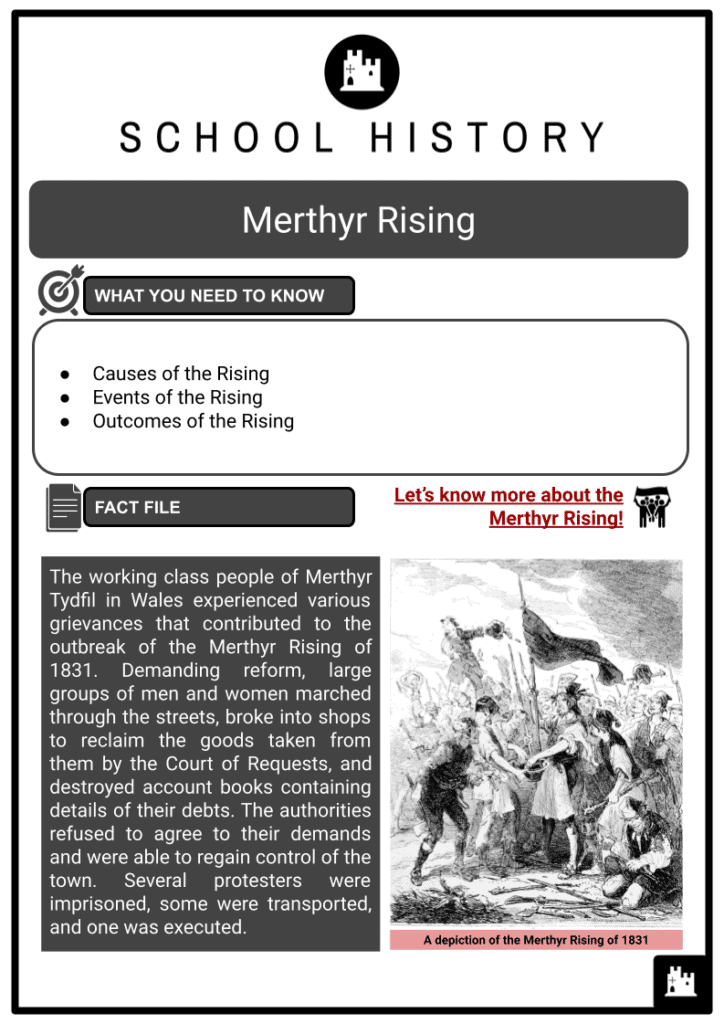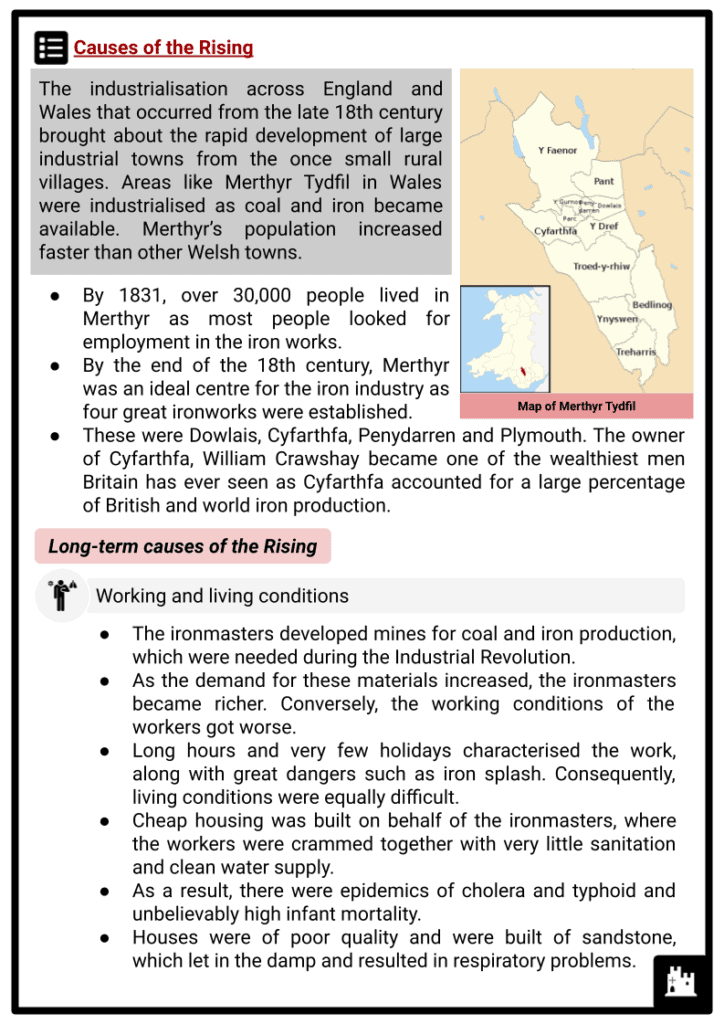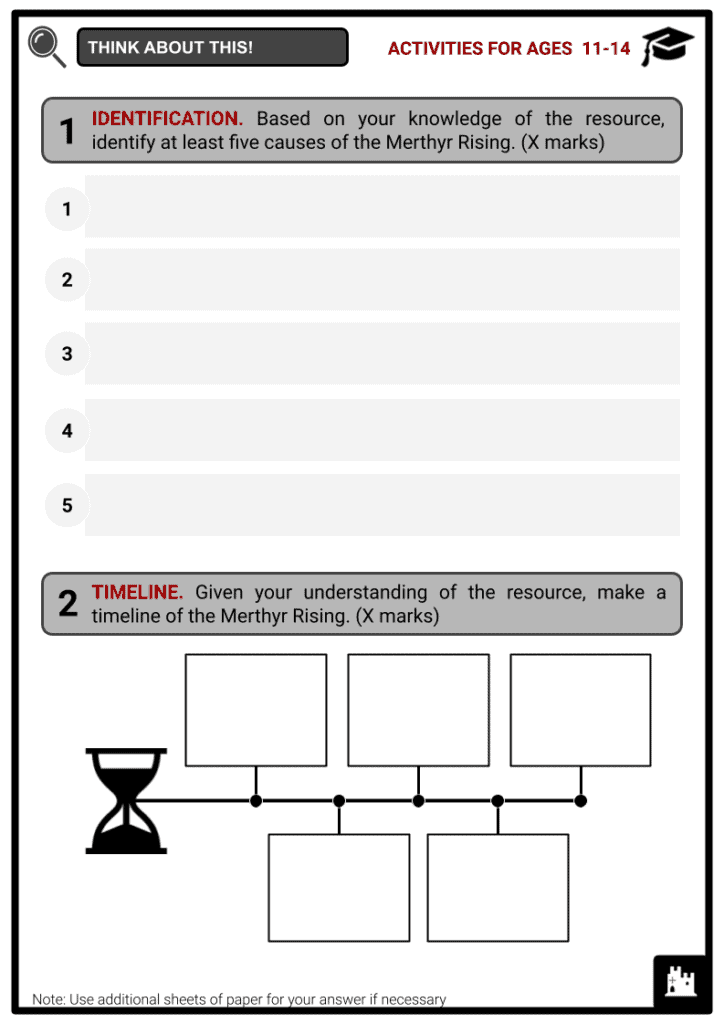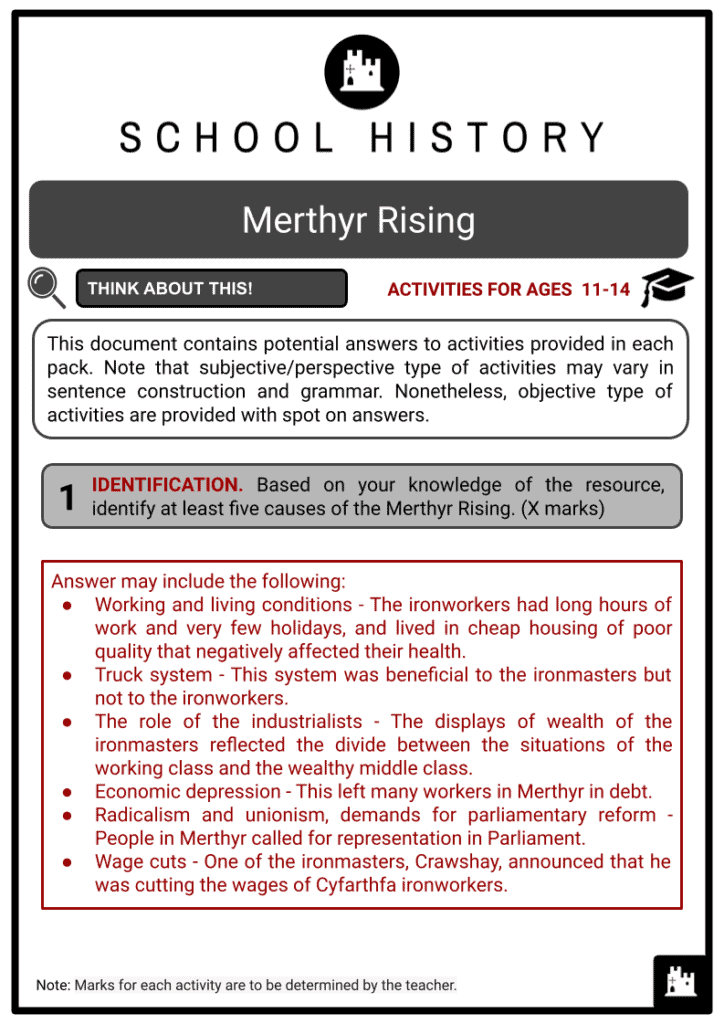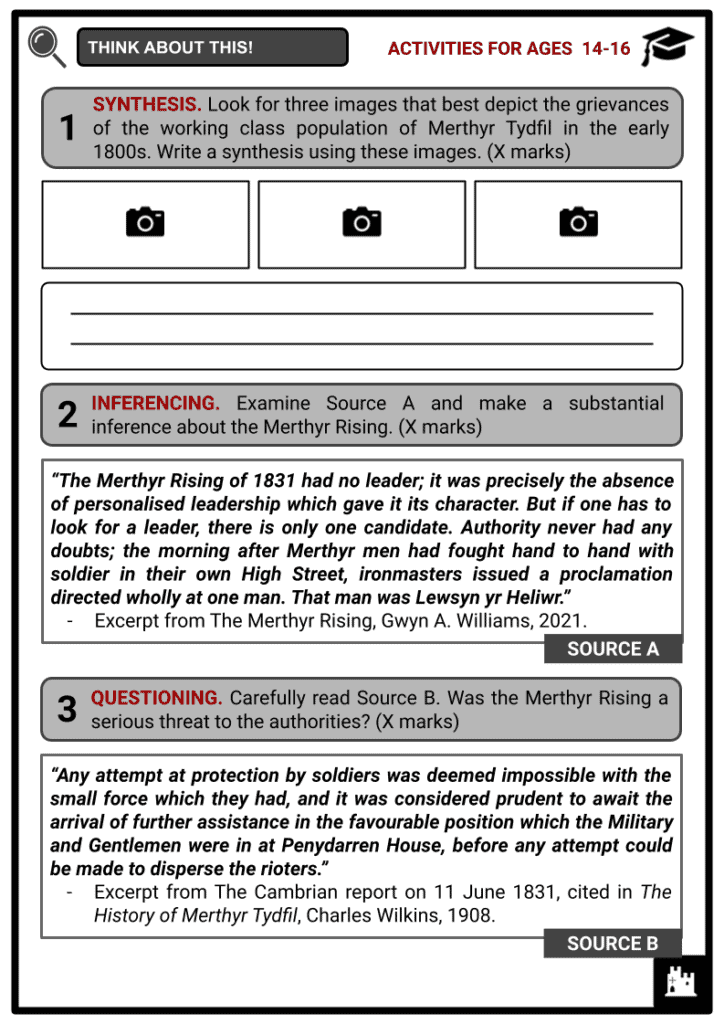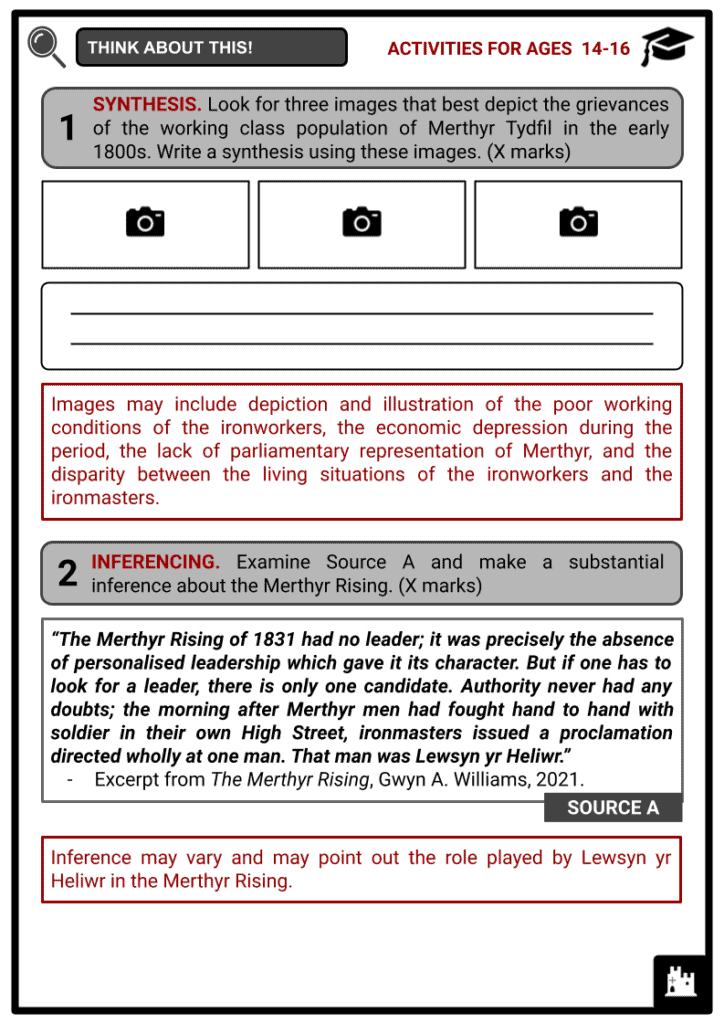Merthyr Rising Worksheets
Do you want to save dozens of hours in time? Get your evenings and weekends back? Be able to teach about Merthyr Rising to your students?
Our worksheet bundle includes a fact file and printable worksheets and student activities. Perfect for both the classroom and homeschooling!
Summary
- Causes of the Rising
- Events of the Rising
- Outcomes of the Rising
Key Facts And Information
Let’s know more about the Merthyr Rising!
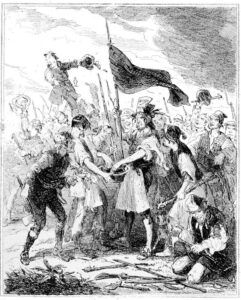
The working class people of Merthyr Tydfil in Wales experienced various grievances that contributed to the outbreak of the Merthyr Rising of 1831. Demanding reform, large groups of men and women marched through the streets, broke into shops to reclaim the goods taken from them by the Court of Requests, and destroyed account books containing details of their debts. The authorities refused to agree to their demands and were able to regain control of the town. Several protesters were imprisoned, some were transported, and one was executed.
Causes of the Rising
- The industrialisation across England and Wales that occurred from the late 18th century brought about the rapid development of large industrial towns from the once small rural villages. Areas like Merthyr Tydfil in Wales were industrialised as coal and iron became available. Merthyr’s population increased faster than other Welsh towns.
- By 1831, over 30,000 people lived in Merthyr as most people looked for employment in the iron works.
- By the end of the 18th century, Merthyr was an ideal centre for the iron industry as four great ironworks were established.
- These were Dowlais, Cyfarthfa, Penydarren and Plymouth. The owner of Cyfarthfa, William Crawshay became one of the wealthiest men Britain has ever seen as Cyfarthfa accounted for a large percentage of British and world iron production.
Long-term causes of the Rising
Working and living conditions
- The ironmasters developed mines for coal and iron production, which were needed during the Industrial Revolution.
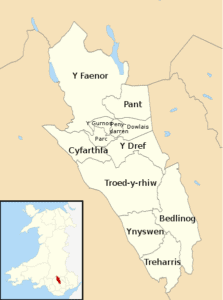
Map of Merthyr Tydfil - As the demand for these materials increased, the ironmasters became richer. Conversely, the working conditions of the workers got worse.
- Long hours and very few holidays characterised the work, along with great dangers such as iron splash. Consequently, living conditions were equally difficult.
- Cheap housing was built on behalf of the ironmasters, where the workers were crammed together with very little sanitation and clean water supply.
- As a result, there were epidemics of cholera and typhoid and unbelievably high infant mortality.
- Houses were of poor quality and were built of sandstone, which let in the damp and resulted in respiratory problems.
Truck system
- Aside from the poor working and living conditions, the truck system in Merthyr aggravated the situation of the workers. The truck system favoured the ironmasters who owned the ‘tommy shops’.
- Prices of goods in tommy shops tended to be higher than in ordinary shops. The goods were also of inferior quality.
The role of the industrialists
- Some of the industrialists who owned the ironworks made great contributions to Merthyr.
- One of the influential ironmasters, Josiah John Guest, the owner of Dowlais, built a library, chapels and schools for their workers. In 1825, Crawshay ordered a castle to be built for himself overlooking Cyfarthfa works.
- These displays of wealth of the ironmasters reflected the divide between the situations of the working class and the wealthy middle class.
Short-term causes of the Rising
Economic depression
- The economic depression was fuelled by a fall in the demand for iron in 1829 and lasted for three years, heavily affecting the iron industry.
- As the prices of goods increased, the lives of working people became harder, forcing families to resort to debt.
- When families could not pay the debt, the Court of Requests kept records and would then send bailiffs to seize goods. The people of Merthyr hated this debtors’ court.
Radicalism and unionism, demands for parliamentary reform
- Whilst the appeal of radicalism lessened during the 1820s because of the country’s general economic recovery, the demand for parliamentary reform remained strong in Merthyr.
- Merthyr had no representation in Parliament, unlike rotten boroughs that still existed. The workers in the town wanted a representation to improve their living conditions. The industrialists also supported the reform campaign that was dominating British politics at the time.
- Unionism was also seen as one way of improving workers’ lives. The Unions, such as the Colliers Union, tried to strengthen their position in Merthyr and this seemed to have contributed to the Rising.
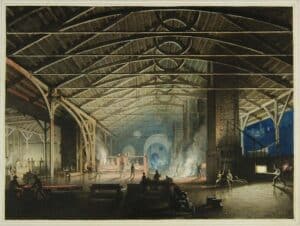
A depiction of Cyfarthfa ironworks in 1825
Wage cuts
- Prior to the Rising, a mass meeting of ironworkers was held at Waun Common on 30 May 1831, which was considered to be the largest political meeting of workers held in Wales.
- This reflected the prevalence of the workers that were joining the organisation.
- Due to the effects of the economic depression, Crawshay announced that he was cutting the wages of Cyfarthfa ironworkers, which led to the workers’ meeting.
- Aside from the wage cuts, the situation was exacerbated when Crawshay sacked 84 puddlers.
- The town was enraged by this action, coupled with the grievances experienced by the people of Merthyr.
The Merthyr Rising began shortly after the mass meeting of ironworkers.
Events of the Rising
- Lewis Lewis (Lewsyn yr Heliwr or Lewis the Huntsman) refused to give up property when the bailiffs from the Court of Requests visited to recover debts. This challenged the authority of the Court, but they eventually reached a compromise and the bailiffs took a trunk belonging to Lewis. An angry crowd at Hirwaun took back Lewis’ trunk from a shopkeeper, who had taken possession of it the next day. This started the general repatriation of goods taken by the Court of Requests.
2 June 1831
- The growing angry crowd went from house to house in Merthyr, taking goods seized by the Court of Requests. The house of a bailiff, Thomas Williams, was ransacked and by the afternoon, more ironworkers had joined the crowd.
- While the crowd continued to grow in size, the magistrates and ironmasters took up residence at the Castle Inn, with about 70 Special Constables.
- When the Chief Magistrate J.B. Bruce, accompanied by Anthony Hill, failed to persuade the crowd to disperse, the Riot Act was read in Welsh and English, but the crowd remained.
- The house of Joseph Coffin, the President of the Court of Requests, became the target of the crowd. The crowd stormed the house, destroying the records of people’s debts.
- The crowd reached 10,000 and is believed to have marched under a red flag. As the Brecon soldiers arrived at the Castle Inn, a deputation of a crowd detailed their demands:
- Abolition of the Court of Requests
- Higher wages
- Reform
- A reduction in the cost of essential working equipment
- The deputation returned to the crowd when the ironmasters refused to give in to the demands. Crawshay addressed the crowd from the Castle Inn and the High Sheriff told the crowd to disperse. The crowd was enraged and tried to surround the soldiers while Lewis Lewis called for the soldiers to be disarmed.
- The crowd eventually dispersed when the soldiers violently responded, killing three of the crowd instantly when they opened fire from the windows of the Inn. Sixteen soldiers were wounded and about 24 of the crowd were killed (actual number remains unknown).
3 June 1831
- The crowd ambushed and took the arms of the Swansea Yeomanry who arrived from Neath.
- While the crowd met with another deputation of protesters near the gates of Cyfarthfa Castle, the march started to break up due to increasing military presence and a lack of common objectives. This was the turning point in the Rising.
6 June 1831
- Another meeting between a crowd ranging from 12,000–20,000 and the Merthyr protesters was planned at Waun. The authorities decided to pre-empt this massive protest by sending troops.
- The Riot Act was read and the soldiers levelled their muskets. The leaders of the Rising fled while the crowd panicked. The 18 leaders, including Lewis Lewis, were eventually caught and panic spread throughout Merthyr. They were sent to Cardiff prison to await trial.
Outcomes of the Rising
- The authorities’ response to the Rising made it clear that protests as a way to achieve reforms were not tolerated. An example was to be made in order to deter others.
- The Merthyr Rising of 1831 that came as a shock resulted in both short- and long-term effects.
- The events of the Rising were debated and investigated in the House of Commons to find out the how and why it came about.
- While Crawshay was partly blamed for his role in the Rising, the authorities were determined to punish the leaders to show that violence would not be allowed.
The execution of Richard Lewis (Dic Penderyn)
- The accused were tried on 13 July 1831. Twenty-eight men and women were charged for house raids and seizing weapons. Some were transported for life. Some were punished with hard labour while some were acquitted.
- Lewis Lewis was charged for robbery in addition to attacking Thomas Lewis’ house, but he was found not guilty of the attack and was transported.
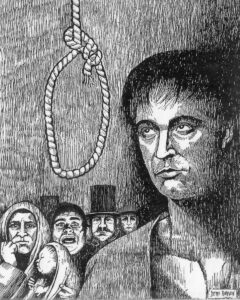
An illustration of Richard Lewis sent to the gallows - Richard Lewis (Dic Penderyn) was charged for attacking and wounding a Highlander soldier Donald Black with a bayonet. He was found guilty and sentenced to death as he was identified by two Special Constables, including James Abbott, who had a previous disagreement with Lewis.
- When the trial ended, petitions for mercy were sent but the Home Secretary Lord Melbourne decided to make an example of Richard Lewis to discourage dissent.
- Richard Lewis was executed in Cardiff.
Unions were stamped out
- The immediate fallout of the Merthyr Rising was that workers were forced to give up the Union.
- The ironmasters led by Josiah John Guest decided on the removal of the Unions.
- Workers at Dowlais and Plymouth were told to either give up the Union or lose their jobs.
- Those who chose to stay with the Union were locked out of work, which eventually led to poverty and starvation until they were left with no choice but to return to work.
The Truck Act was passed
- While the passing of the Truck Act was not a direct consequence of the Rising, the government made the practice of paying workers tokens illegal.
- It was the result of the government’s concern over the prevalence of the truck system that abused the working class.
- This was a positive outcome of the Rising.
Parliamentary representation
- The first representative of Merthyr in Parliament was Josiah John Guest, one of the ironmasters.
- The Reform Act that was supported by the working class gave industrial and political power to the ironmasters.
The industrial and rural protests in England and Wales, such as the Merthyr Rising of 1831, drove various outcomes. While the Rising failed in its aims, it became a significant part of the history of the Welsh working class.
Image Sources
- https://upload.wikimedia.org/wikipedia/commons/thumb/3/3c/Merthyr_Rising.jpg/800px-Merthyr_Rising.jpg
- https://upload.wikimedia.org/wikipedia/commons/thumb/f/f1/Map_of_Merthyr_Tydfil_communities_%28Welsh_labels%29.svg/446px-Map_of_Merthyr_Tydfil_communities_%28Welsh_labels%29.svg.png?20190915171512
- https://en.wikipedia.org/wiki/Cyfarthfa_Ironworks#/media/File:'Cyfarthfa_Ironworks_Interior_at_Night',_by_Penry_Williams,_(1825).jpg
- http://www.alangeorge.co.uk/Images_D-H/DicPenderyn_12-1.jpg

